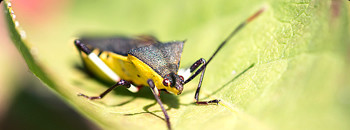Written by: Robin L. Tabuchi, Research Entomologist, University of California, Berkeley.
Considering it’s February, I’m guessing many of you have already forgotten your New Year’s resolutions. Whether you vowed to hit the gym, learn to cook like Gordon Ramsey or finally clean your rain gutters, let’s make a few easy pest prevention resolutions that won’t break your back or your budget.
Search the perimeter of your house. What are you looking for? Anything out of the ordinary, but pay specific attention to the things listed below. If you have kids, invite them to join you. Tell them you are going on a scavenger hunt and ask them to help you find:
- Holes. Are there any potential rodent entry points? Rats can enter a structure through a ½ inch hole and mice can enter through a ¼ inch hole. They also are very good climbers and can gain access to a structure through pipes, along wires and from climbing trees or vines. Look for holes in the roof, around windows, doors and crawl space vents.
- Mud tubes. Mud tubes are the pathways subterranean termites use to travel from their nest in the soil to food sources (cellulose material, “aka” wood) in your house. They are constructed of soil and held together with termite saliva. Pay specific attention to areas of higher moisture, such as rain gutter downspouts and walls adjacent to bathrooms.
- Trees. Make sure trees adjacent to your house are not touching the structure. This creates an easy entry point for many pests, including rodents and ants.
Store firewood wisely. Even through it’s convenient to pile firewood alongside your house, it isn’t wise. You don’t want foraging termites to set up shop in your firewood and then move their operation next door to a more spacious site; your house. Move firewood away from the structure and stack it on top of concrete blocks. This limits the amount of soil-to-wood contact, and you can more easily see mud tubes, if they appear.
Harvest fruit trees. If you have fruit trees, especially citrus or pomegranates, harvest the fruit from the trees when ripe and try not to let it fall and sit on the ground. Fallen fruit attracts rodents and ants.
Check your buds. Search buds on flowering plants for aphids and scale insects. If you find them, treat them before the buds break to ensure the flowers and emerging leaves stay alive and healthy.
Following these resolutions will help you prevent common and potentially costly household pest infestations. What do you do if a pest still finds its way in? You can try tackling the problem yourself or contact a local pest control company. Lastly, visit UC Davis’s IPM online page for pest identification, biology and management information.
Robin L. Tabuchi is a research entomologist at the University of California, Berkeley. Currently, she manages a research lab on finding ways to prevent and control many household and structural pests, including bed bugs, subterranean and drywood termites and argentine ants.

